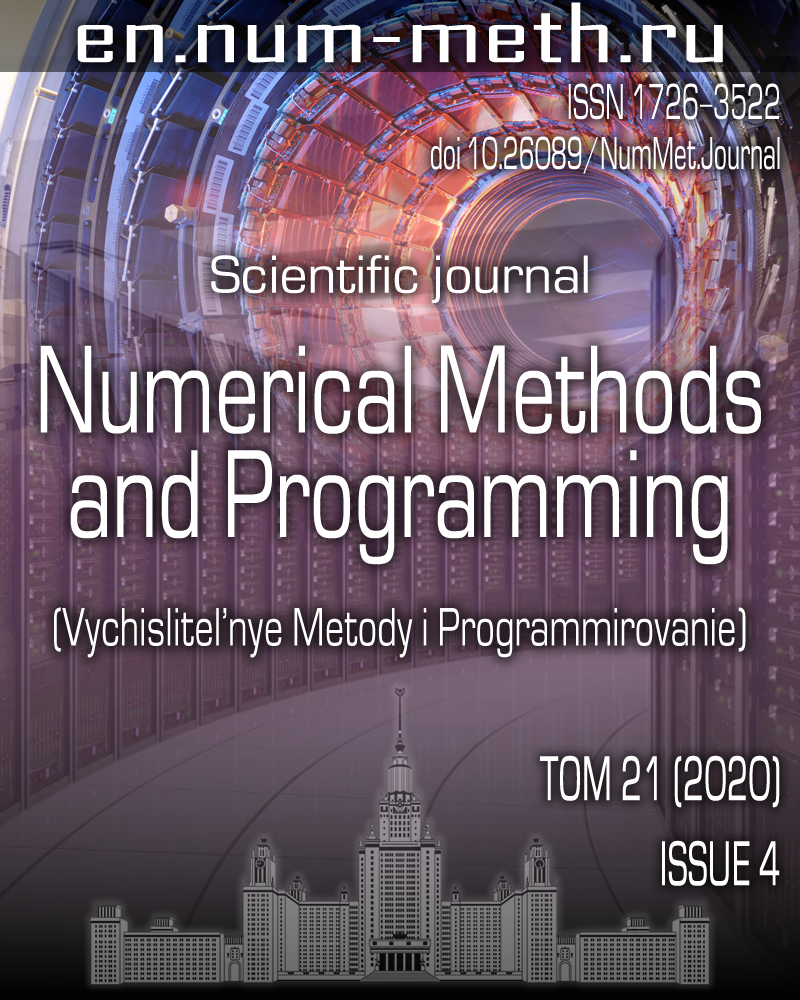DOI: https://doi.org/10.26089/NumMet.v21r431
On the stability analysis of flows in channels of elliptic cross section using the finite element method on unstructured meshes
Keywords:
Abstract
The existing technique for the numerical analysis of incompressible fluid flow stability in channels of constant cross section was earlier extended to the case of local spatial approximations on unstructured meshes, which leads to large sparse matrices. The finite element method is employed for spatial approximation and a new efficient Newton-type method is used to solve partial eigenvalues problems arising in flow stability analysis. A detailed numerical study of the proposed approach is carried out in this paper by the example of Poiseuille flow in a channel of elliptic cross section. Performance ability of the approach is demonstrated for a wide range of the cross-sectional semiaxes ratio, including the case of linear instability of the flow under consideration. The convergence of the leading part of the spectrum with respect to the grid size is shown. Our results are in good agreement with those obtained via approximation by the spectral collocation method.
Published
Issue
Section
References
- A. V. Boiko and Yu. M. Nechepurenko, “Numerical Spectral Analysis of Temporal Stability of Laminar Duct Flows with Constant Cross Sections,” Zh. Vychisl. Mat. Mat. Fiz. 48 (10), 1731-1747 (2008) [Comput. Math. Math. Phys. 48 (10), 1699-1714 (2008)].
- A. V. Boiko and Yu. M. Nechepurenko, “Numerical Study of Stability and Transient Phenomena of Poiseuille Flows in Ducts of Square Cross-Sections,” Russ. J. Numer. Anal. Math. Modelling 24 (3), 193-205 (2000).
- A. V. Boiko and Yu. M. Nechepurenko, “Technique for the Numerical Analysis of the Riblet Effect on Temporal Stability of Plane Flows,” Zh. Vychisl. Mat. Mat. Fiz. 50 (6), 1109-1125 (2010) [Comput. Math. Math. Phys. 50 (6), 1055-1070 (2010)].
- A. V. Boiko, K. V. Demyanko, and Yu. M. Nechepurenko, “Numerical Analysis of Spatial Hydrodynamic Stability of Shear Flows in Ducts of Constant Cross Section,” Zh. Vychisl. Mat. Mat. Fiz. 58 (5), 726-740 (2018) [Comput. Math. Math. Phys. 58 (5), 700-713 (2018)].
- N. V. Klyushnev, On Utilizing the Finite Element Method on Unstructured Meshes for Stability Analysis of Flows in Channels of Constant Cross-Section , Preprint No. 30 (Keldysh Institute of Applied Mathematics, Moscow, 2020).
- P. J. Schmid and D. S. Henningson, Stability and Transition in Shear Flows (Springer, New York, 2001).
- A. V. Boiko, A. V. Dovgal, G. R. Grek, and V. V. Kozlov, Physics of Transitional Shear Flows (Springer, Dordrecht, 2012).
- B. Fornberg, “A Pseudospectral Approach for Polar and Spherical Geometries,” SIAM J. Sci. Comp. 16 (5), 1071-1081 (1995).
- K. V. Demyanko, “Numerical Model for the Investigation of Hydrodynamic Stability of Shear Flows in Pipes of Elliptic Cross-Section,” Russ. J. Numer. Anal. Math. Modelling 34 (6), 301-316 (2019).
- P. J. Schmid and D. S. Henningson, “Optimal Energy Density Growth in Hagen-Poiseuille Flow,” J. Fluid Mech. 277, 197-225 (1994).
- J. Shen, “Efficient Spectral-Galerkin Methods III: Polar and Cylindrical Geometries,” SIAM J. Sci. Comput. 18 (6), 1583-1604 (1997).
- M. D. Gunzburger, Finite Element Methods for Viscous Incompressible Flows (Academic Press, Boston, 1989).
- K. V. Demyanko, Yu. M. Nechepurenko, and M. Sadkane, “ A Newton-like Method for Computing Deflating Subspaces,” J. Numer. Math. 23 (4), 289-301 (2015).
- K. V. Demyanko, I. E. Kaporin, and Yu. M. Nechepurenko, “Inexact Newton Method for the Solution of Eigenproblems Arising in Hydrodynamic Temporal Stability Analysis,” J. Numer. Math. 28 (1), 1-14 (2020).
- V. Theofilis, “Advances in Global Linear Instability Analysis of Nonparallel and Three-Dimensional Flows,” Prog. Aerosp. Sci. 39 (4), 249-315 (2003).
- K. V. Demyanko and Yu. M. Nechepurenko, “Dependence of the Linear Stability of Poiseuille Flows in a Rectangular Duct on the Cross-Sectional Aspect Ratio,” Dokl. Akad. Nauk 440 (5), 618-620 (2011) [Dokl. Phys. 56 (10), 531-533 (2011)].
- K. V. Demyanko and Yu. M. Nechepurenko, “Linear Stability Analysis of Poiseuille Flow in a Rectangular Duct,” Russ. J. Numer. Anal. Math. Modelling 28 (2), 125-148 (2013).
- A. V. Boiko, N. V. Klyushnev, and Yu. M. Nechepurenko, Stability of Shear Flows over a Grooved Surface (Keldysh Institute of Applied Mathematics, Moscow, 2016). [in Russian],
doi 10.20948/mono-2016-klyushnev - A. V. Boiko, N. V. Klyushnev, and Yu. M. Nechepurenko, “On Stability of Poiseuille Flow in Grooved Channels,” Europhys. Lett. 111 (1), 14001.p1-14001.p6 (2015).
- O. A. Grigoriev and N. V. Klyushnev, “Stability of the Poiseuille Flow in a Channel with Comb Grooves,” Zh. Vychisl. Mat. Mat. Fiz. 58 (4), 595-606 (2018) [Comput. Math. Math. Phys. 58 (4), 581-592 (2018)].
- P. G. Drazin and W. H. Reid, Hydrodynamic Stability (Cambridge University Press, Cambridge, 2004).
- Yu. M. Nechepurenko, “On the Dimension Reduction of Linear Differential-Algebraic Control Systems,” Dokl. Akad. Nauk 445 (1), 17-19 (2012) [Dokl. Math. 86 (1), 457-459 (2012)].
- G. H. Golub and C. F. van Loan, Matrix Computations (John Hopkins Univ. Press, Baltimore, 1996; Mir, Moscow, 1999).
- C. Taylor and P. Hood, “A Numerical Solution of the Navier-Stokes Equations Using the Finite Element Technique,” Comput. Fluids 1 (1), 73—100 (1973).
- A. Logg, K.-A. Mardal, and G. Wells (Eds), Automated Solution of Differential Equations by the Finite Element Method (Springer, Berlin, 2012).
- A. Ribes and C. Caremoli, “Salomé Platform Component Model for Numerical Simulation,” in Proc. 31st Annual Int. Computer Software and Applications Conference (COMPSAC 2007), Beijing, China, July 24-27, 2007 (IEEE Press, Washington D.C., 2007), Vol. 2, pp. 553-564.
- R. R. Kerswell and A. Davey, “On the Linear Instability of Elliptic Pipe Flow,” J. Fluid. Mech. 316, 307-324 (1996).


